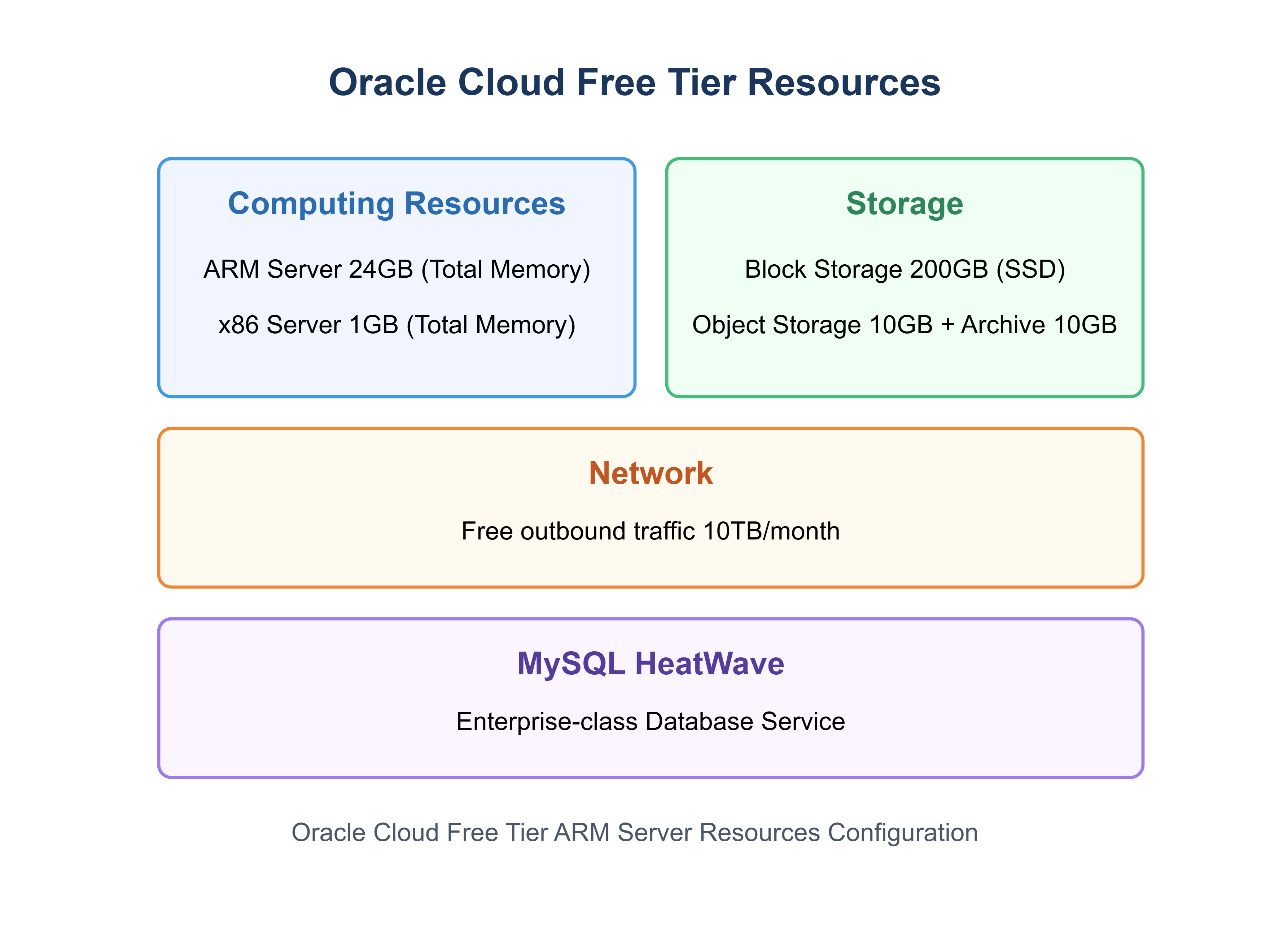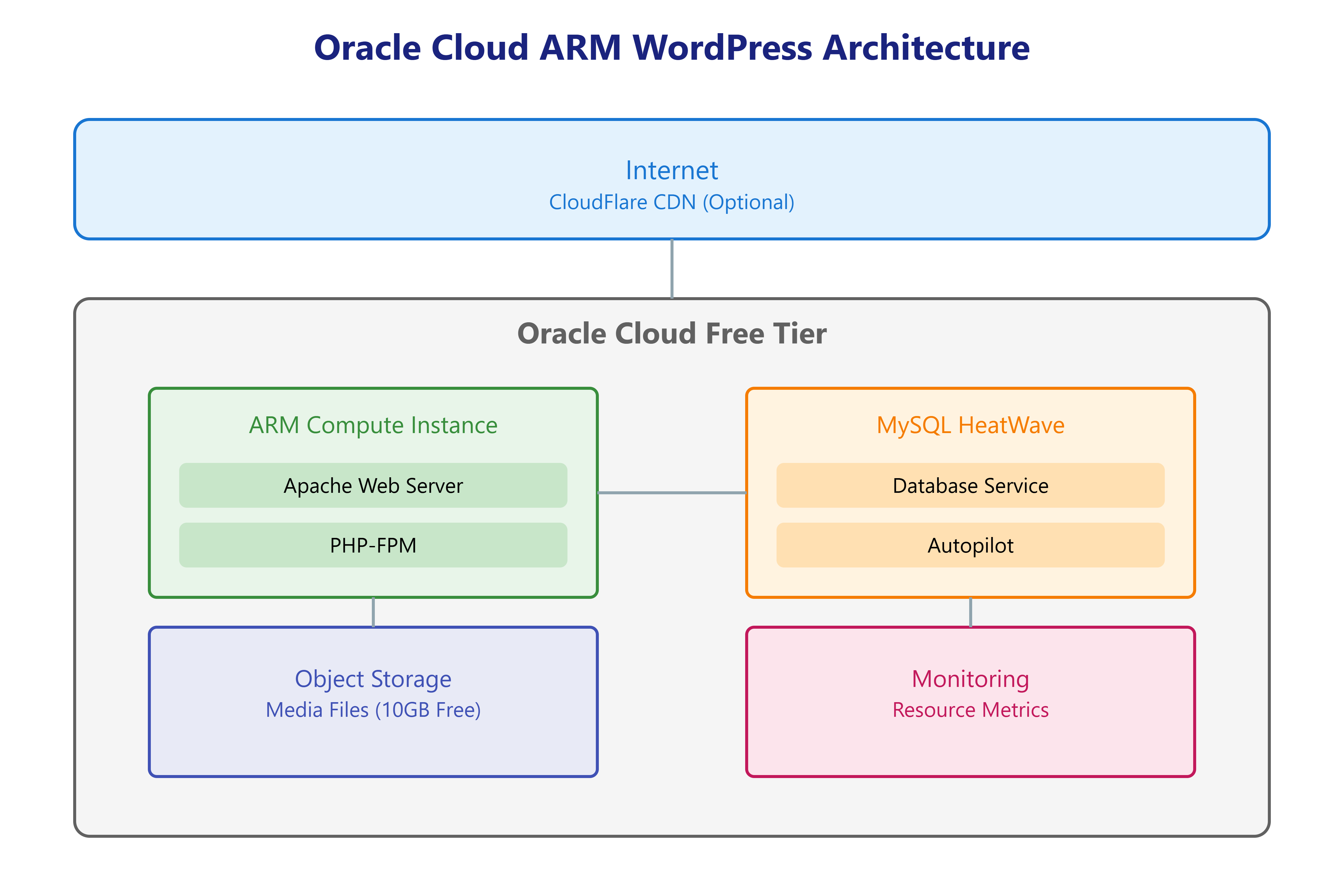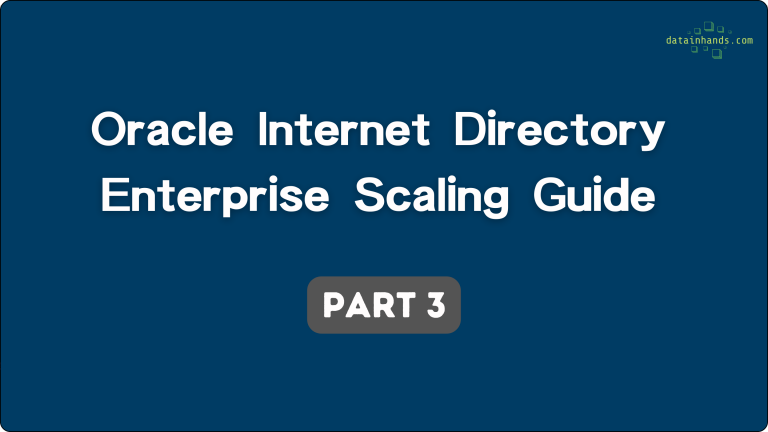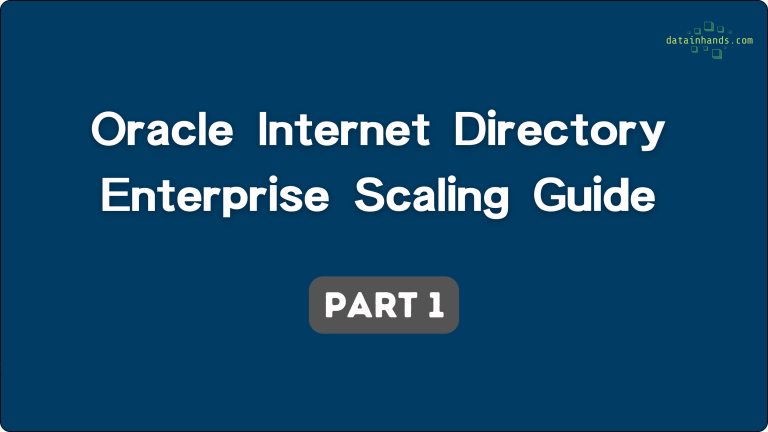Setting Up WordPress on Oracle Cloud ARM Servers: The Ultimate 2025 Guide
Table of Contents
ToggleEver wondered how to build a blazing-fast WordPress site without spending a penny? Today, I’m sharing my hands-on experience setting up WordPress on Oracle Cloud’s ARM servers. And trust me, what Oracle offers in their “Always Free” tier is nothing short of amazing.
Why Oracle Cloud's Free Tier Stands Out
Let’s talk about something game-changing in the cloud computing world. While AWS, Google Cloud, and Azure limit their free tiers to 12 months, Oracle Cloud takes a completely different approach with their “Always Free” resources. They’re not just giving you a taste – they’re serving up a full plate of enterprise-grade computing power.
Here’s what makes Oracle Cloud’s free tier extraordinary:
Computing Muscle:
You get not one, but two ARM-based virtual machines, packing a total of 24GB memory and 3,000 OCPU hours per month. But wait, there’s more – you also get two x86-based VMs, each with 1GB memory and 0.125 OCPU. This isn’t your typical “trial” offering – it’s serious computing power that’s yours to keep.
Storage That Makes Sense:
Forget about tiny storage allocations. Oracle gives you 200GB of block storage (yes, that’s high-performance SSD), 10GB of object storage, and another 10GB of archive storage. To put this in perspective, that’s enough space to host a content-rich WordPress site with plenty of room for growth.
Network Freedom:
Here’s where Oracle really shines – you get 10TB of free outbound traffic monthly. If you’ve ever dealt with cloud providers’ data transfer fees, you know how significant this is. It’s like having a highway with no toll gates.
Let's Build Something Amazing
1. Setting Up Your Foundation
First, let’s talk about how I’ve architected my WordPress setup. This isn’t just any configuration – it’s been battle-tested and optimized for ARM infrastructure.
# First, let's update our system and install essential packages sudo dnf update -y sudo dnf install -y httpd php php-mysqlnd php-fpm # Start and enable our web services sudo systemctl start httpd sudo systemctl enable httpd sudo systemctl start php-fpm sudo systemctl enable php-fpm
Why this configuration? The ARM architecture brings some unique advantages to the table. It’s not just about power efficiency – these processors are particularly good at handling concurrent web requests, which is perfect for WordPress.
2. Database Magic with MySQL HeatWave
Now, let’s set up something special – MySQL HeatWave. This isn’t your ordinary database setup. HeatWave is MySQL’s secret weapon, and on Oracle Cloud, it sings:
-- Let's create our WordPress database environment CREATE DATABASE wordpress_db; CREATE USER 'wordpress_user'@'%' IDENTIFIED BY 'your_password'; GRANT ALL PRIVILEGES ON wordpress_db.* TO 'wordpress_user'@'%'; FLUSH PRIVILEGES;
3. Performance Optimization for ARM
Here’s where things get really interesting. Running WordPress on ARM requires some special considerations. Let’s optimize PHP-FPM specifically for our ARM environment:
; /etc/php-fpm.d/www.conf pm = dynamic pm.max_children = 50 pm.start_servers = 5 pm.min_spare_servers = 5 pm.max_spare_servers = 35 pm.max_requests = 500 ; Optimize PHP memory settings memory_limit = 256M max_execution_time = 300 max_input_time = 300 post_max_size = 64M upload_max_filesize = 32M
These settings aren’t arbitrary – they’re carefully tuned for ARM architecture. The dynamic process manager ensures we’re using resources efficiently, while the memory limits give WordPress room to breathe without going overboard.
4. Building a Rock-Solid Caching System
When it comes to WordPress performance, caching is your secret weapon. Here’s how I’ve implemented a multi-layer caching strategy that takes full advantage of our ARM architecture:
// First, let's configure WordPress caching in wp-config.php define('WP_CACHE', true); define('WPCACHEHOME', '/var/www/html/wp-content/plugins/wp-super-cache/'); // Redis object caching configuration define('WP_REDIS_HOST', 'redis'); define('WP_REDIS_PORT', 6379); define('WP_REDIS_TIMEOUT', 1); define('WP_REDIS_READ_TIMEOUT', 1); define('WP_REDIS_DATABASE', 0);
But why this specific setup? Think of caching like a multi-story building. At the ground floor, we have OPcache handling PHP code compilation. The middle floor is Redis, managing object caching. And at the top, we have browser caching dealing with static assets. Each layer plays a crucial role in delivering lightning-fast page loads.
Here’s our optimized OPcache configuration:
opcache.memory_consumption=128 opcache.interned_strings_buffer=8 opcache.max_accelerated_files=4000 opcache.revalidate_freq=60 opcache.fast_shutdown=1 opcache.enable_cli=1
5. Security: Because Free Doesn't Mean Vulnerable
Just because we’re using a free tier doesn’t mean we should compromise on security. Here’s my battle-tested security configuration:
# Let's set up our firewall properly sudo firewall-cmd --permanent --add-service=http sudo firewall-cmd --permanent --add-service=https # Enhance SSH security sudo sed -i 's/#PermitRootLogin yes/PermitRootLogin no/' /etc/ssh/sshd_config sudo sed -i 's/#PasswordAuthentication yes/PasswordAuthentication no/' /etc/ssh/sshd_config # Configure IP tables for better security iptables -A INPUT -p tcp --dport 22 -s trusted_ip_range -j ACCEPT iptables -A INPUT -p tcp --dport 22 -j DROP iptables -A INPUT -p tcp --dport 80 -j ACCEPT iptables -A INPUT -p tcp --dport 443 -j ACCEPT
Let’s talk about SSL/TLS configuration. We’re using Let’s Encrypt because, well, why pay for SSL when you can get it for free without compromising security?
# Install and configure Let's Encrypt sudo certbot --apache -d yourdomain.com sudo certbot --apache -d www.yourdomain.com # Set up automatic renewal echo "0 0 1 * * /usr/bin/certbot renew --quiet --post-hook 'systemctl restart httpd'" | sudo tee -a /etc/crontab
6. Monitoring: Because Knowledge is Power
Here’s a comprehensive monitoring script I’ve developed that keeps an eye on everything:
#!/bin/bash # # comprehensive_monitor.sh # Purpose: Monitor WordPress installation on Oracle Cloud ARM server # Monitors system resources, WordPress status, and database health # Outputs monitoring data to a log file for analysis # # Configuration variables LOG_FILE="$HOME/wordpress_monitor.log" # Store logs in user's home directory for better security DB_USER="your_db_user" # Database username DB_PASS="your_db_password" # Database password WP_URL="http://localhost" # WordPress installation URL # Function to monitor system status and write to log file monitor_system() { # Write timestamp for this monitoring session echo "=== System Status Check: $(date) ===" >> "$LOG_FILE" # Monitor system memory usage and write to log echo "Memory Usage:" >> "$LOG_FILE" free -m >> "$LOG_FILE" # Monitor CPU utilization and top processes echo "CPU Usage:" >> "$LOG_FILE" top -bn1 | head -n 20 >> "$LOG_FILE" # Check WordPress accessibility and response WP_STATUS=$(curl -sL -o /dev/null -w "%{http_code}" "$WP_URL/wp-cron.php") echo "WordPress cron check status: $WP_STATUS" >> "$LOG_FILE" # Check database health and active connections mysql -u "$DB_USER" -p"$DB_PASS" -e "SHOW PROCESSLIST\G" >> "$LOG_FILE" 2>/dev/null # Add a separator line for better log readability echo "----------------------------------------" >> "$LOG_FILE" } # Main execution monitor_system # Exit successfully exit 0
This script isn’t just about collecting data – it’s about understanding your system’s behavior and catching issues before they become problems.
7. Maintenance Best Practices
Regular maintenance is crucial for keeping your WordPress site running smoothly. Here’s my tried-and-tested maintenance routine:
#!/bin/bash # # maintenance.sh # Purpose: Essential WordPress maintenance tasks focusing on database and cache # # Configuration variables DB_NAME="wordpress_db" DB_USER="your_db_user" DB_PASS="your_db_password" WP_PATH="/var/www/html" # Main maintenance function maintenance() { echo "=== Starting WordPress Maintenance: $(date) ===" # Database optimization - Essential for maintaining database performance echo "Optimizing WordPress tables..." mysql -u "$DB_USER" -p"$DB_PASS" -e "OPTIMIZE TABLE wp_posts, wp_postmeta, wp_options;" "$DB_NAME" # WordPress cache flush - Critical for ensuring fresh content delivery echo "Flushing WordPress cache..." if [ -f "$WP_PATH/wp-config.php" ]; then sudo -u www-data wp cache flush --path="$WP_PATH" fi # Redis cache flush - Important for maintaining application performance if command -v redis-cli >/dev/null 2>&1; then if redis-cli ping >/dev/null 2>&1; then echo "Flushing Redis cache..." redis-cli FLUSHDB fi fi echo "=== Maintenance Completed: $(date) ===" } # Execute maintenance maintenance
8. Final Thoughts and Best Practices
Running WordPress on Oracle Cloud’s ARM servers offers a unique opportunity to host a professional website at no cost. This setup isn’t just about saving money – it’s about leveraging enterprise-grade infrastructure for optimal performance.
Key takeaways from our guide:
- ARM-based servers provide excellent performance for WordPress workloads
- MySQL HeatWave optimization ensures fast database operations
- Multi-layer caching strategy (OPcache, Redis, browser caching) delivers quick page loads – Regular maintenance using our optimized scripts keeps your site running smoothly
- Comprehensive backup strategy protects your content
- Professional security measures safeguard your installation
For best results:
- Run regular maintenance tasks using our provided scripts
- Monitor system performance and resource usage
- Keep WordPress core and plugins updated
- Maintain regular backups
- Review security logs periodically
While Oracle Cloud’s free tier is generous, approach your WordPress installation with the same professionalism as a premium hosting service. This mindset ensures optimal performance and reliability.
Remember to check Oracle’s official documentation regularly for updates about free tier resources and limitations.
📝References
- “Ultimate WordPress Server Optimization Guide 2025: Expert Tips for Oracle Linux 8″
- “Boost WordPress Database Performance by 200% with MySQL HeatWave” – datainhands.com technical blog
- “MySQL HeatWave Autopilot Indexing Guide” – MySQL Technical Documentation
This guide is based on Oracle Cloud Infrastructure features as of January 2025. Please refer to official documentation for the most current information as service policies may change.
#OracleCloud #FreeTier #CloudComputing #WordPress #ARM #MySQL #DevOps #TechBlog







